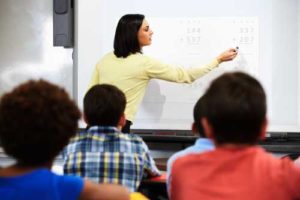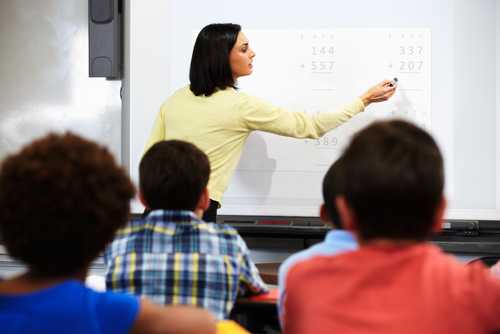New technology is helping teachers model handwriting in a more natural way
 Teaching handwriting to an entire class of students at the same time has always been a compromise. A teacher has always had to stand at a white board to show a class how to form letters, words, and sentences. Usually a whiteboard marker is used; modern technology has sometimes replaced a whiteboard marker with a digital pen that uses an interactive white board (IWB) or, more recently, an interactive projector.
Teaching handwriting to an entire class of students at the same time has always been a compromise. A teacher has always had to stand at a white board to show a class how to form letters, words, and sentences. Usually a whiteboard marker is used; modern technology has sometimes replaced a whiteboard marker with a digital pen that uses an interactive white board (IWB) or, more recently, an interactive projector.
But that’s far from ideal. The problems with these models include:
- When standing at a board, there are usually students who cannot see what is being written. This is just the nature of a classroom with desks. Having students sit on the floor in front of the whiteboard may reduce this problem, but then there is then no room and no flat surface for a student to place a book in order to duplicate the writing skills being taught.
- Teaching writing also involves teaching how to hold a pen. However, holding a pen to write on a vertical white board is different to holding a pen normally to write on paper on a desk. Thus, it is difficult for the teacher to model the correct grip.
- A whiteboard marker (or pen for an IWB) is considerably larger than a traditional pen. It is sometimes a different shape and thickness. Thus, it is difficult to hold the pen the same way a child should hold the pen which makes it almost impossible to model the correct grip.
- Use of an IWB may also produce other problems (unless the school provides one of the newer ultra-short throw projectors). These include:
- Shadows cast by the person standing at the board affecting part of the image.
- Light from the projector shining in the eyes of the person standing at the board.
The entire process is a compromise.
All of these problems can be eliminated by the use of the appropriate technology.
Next page: How to solve the problem with a projector and a tablet
Recently, my school has provided teachers with new tools that help simplify the process, including:
- a MiraCast device connected to classroom projectors. This allows the teacher to demonstrate effective handwriting from any location in the room as it projects the computer screen wirelessly to the projector. Every student in the room has a clear view of the board as the teacher does not have to stand up front.
- a pen based computer/tablet—a Microsoft Surface Pro 3. This is compact and light enough to carry around the classroom.
- The pen also produces fine lines suitable for writing. The tablet is also pressure sensitive, allowing thicker lines by pressing harder. All of the subtleties of traditional handwriting can be modelled.
- The pen also looks and feels like a “real” pen, and thus is held in the same way a “real” pen is held. This allows the teaching of the correct grip.
- The infinitely adjustable kick stand on the Surface Pro 3 allows the tablet to be flat on the desk or slightly raised for a better writing position, and it can be positioned optimally for left and right handed students. The teacher can model the differences for each student from a student’s desk while still demonstrating to the entire class.
- The Surface Pro 3 is the size of an A4 piece of paper, thus matching the traditional medium and keeping the student and teacher in a relatively familiar environment.
The teacher can sit beside any student to demonstrate effective letter formation while demonstrating to the entire class. The teacher can also have a student demonstrate to the class while remaining in his/her seat while holding a “real” pen in a “real” way.
Year 3 (third grade) teacher Nikki Georgiadis has been using this combination of technology to teach handwriting to the whole class from any location in the classroom.
“Using this type of technology has allowed me to model body position, pencil grip, paper position and the formation of letters and numbers,” she said.
“Being able to sit down and be ‘one of the kids’ shows them how to write. I can easily move from desk to desk, allowing for one-on-one instruction where necessary. This has been invaluable as some students take a lot longer than others to understand a concept and some students have special needs. It is easier to maintain the children’s concentration and attention as my back is not to them. I sit with them or next to them. When you have your back turned, the children tend to start writing because they can’t really see what you are doing as you are standing in the way! I can honestly say that after teaching handwriting for 15 years, this is the best method I have ever used to deliver a handwriting lesson. The big clincher—you are not in the way and the entire class is able to see what you are doing!”
In this case, technology has allowed a “learning sweet spot.” The combination of an appropriate pen based computer, a MiraCast device, and an effective projector or screen finally allows handwriting to be taught to a class of students while also teaching the correct handwriting procedures.
- TC- What student choice and agency actually looks like - November 15, 2016
- What student choice and agency actually looks like - November 14, 2016
- App of the Week: Science sensor meets your smartphone - November 14, 2016


